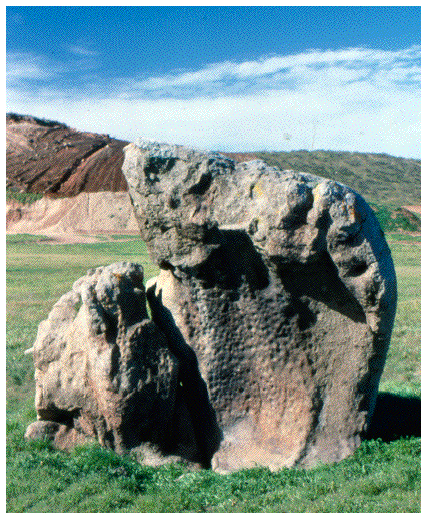CUPULES: LUISENO & CAHUILLA
|
|
|
Cupules
are small depressions ground into the rock. It is reported that sometimes they were made during a ceremony for rain or fertility. This rock may have been used by both the Cahuilla and Luiseno Indians. It is located in Riverside County, California.
Edited image from original photograph by D. McCarthy.
|
CUPULES: LUISENO & CAHUILLA
ARCHEOLOGICAL EXHIBITS AND MUSEUMS
|
Los Angeles County Museum of Natural History.
Los Angeles, CA
|
Palm Springs Desert Museum.
Palm Springs, CA
|
ROCK ART SITES
|
Lake Perris State Recreation Area.
contact: Park Office, Perris, CA
|
Cupules are small cup-shaped, or concave, depressions that were carved into rock surfaces by chipping or grinding. They are usually about the size of a quarter. They can be found on horizontal surfaces, but are more commonly found on vertical surfaces. They may be found alone, or with other forms of rock art, either petroglyphs or pictographs. Cupules have also been found near grinding areas where food was processed.
Cupules are a type of petroglyph that is found all over the world. They are a very old and universal form of rock art. Some have been found in the caves of Paleolithic men in Europe. There is some information about cupules from contemporary tribal people, who still make and use them. There is also some information about cupules present in ethnographic accounts from cultures widely distributed around the world.
It is likely that the cupules in the Southern California cultural areas were created and used for a fertility ceremony. In Northern California cupules are associated with the Shasta Indian rain making ceremonies. The Pomo Indians of Northern California are thought to have made cupules as part of a ritual for human female fertility. Some accounts suggest that the cupules might represent lines of figures or star constellations.
There are over 300 sites in Southern California where this type of rock art is found. They are not specific to any one culture in Southern California. The site listed here was used by Cahuilla and Luiseno people, but there is not much published information about the function of cupules in these cultures.
Source:
Rock Art Of The American Indian
, Campbell Grant, Outbooks, Golden CO, 1981.
Go to contents page | Go to previous section | Go to next section
